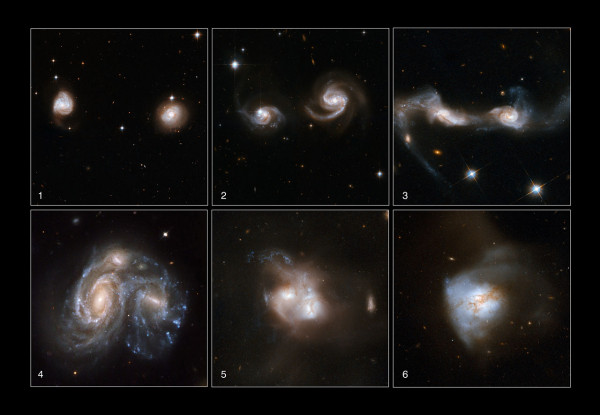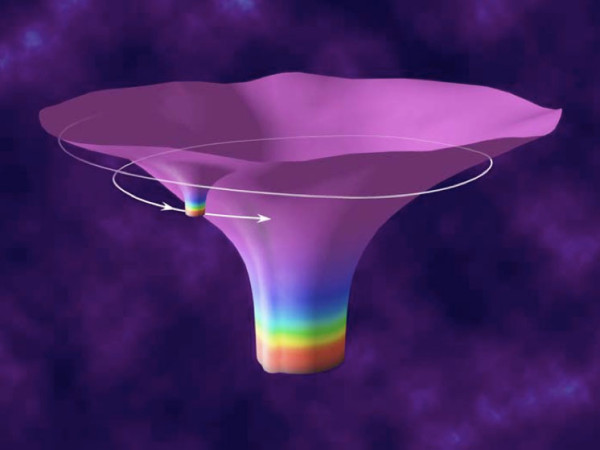We live in a Universe full of galaxies, supermassive black holes, and violence. The violence is particularly relevant here, because every so often, these galaxies merge, and if they each contain a supermassive black hole, the gravitational wave "ripples" that get sent through space will literally shake and affect everything that's in them.
 Image credit: NASA, ESA, the Hubble Heritage Team (STScI/AURA)-ESA/Hubble Collaboration and A. Evans (University of Virginia, Charlottesville/NRAO/Stony Brook University), K. Noll (STScI), and J. Westphal (Caltech).
Image credit: NASA, ESA, the Hubble Heritage Team (STScI/AURA)-ESA/Hubble Collaboration and A. Evans (University of Virginia, Charlottesville/NRAO/Stony Brook University), K. Noll (STScI), and J. Westphal (Caltech).
If you had a perfect clock -- something that kept time perfectly that you could watch "tick" -- you'd expect to see the timing of these ticks be affected. Astrophysics gives us these clocks: millisecond pulsars, in great abundance. Yet the Parkes Pulsar Timing Array project has just completed an 11-year survey of thousands of them, and found no evidence of the gravitational waves they were expecting.
What gives? Is there new physics? Do we have the merger scenarios all wrong? Or is gravity, general relativity and gravitational wave theory all wrong?
Sabine Hossenfelder doesn't have the answer, but she has the evidence, the mystery and the possibilities for you over on Starts With A Bang!


If string theory is at least partly correct, there are extra spatial dimensions. Perhaps gravity waves are carrying off energy as observed, but the waves are dissipating that energy into the other spatial dimensions, causing them to diminish faster than inverse square?
Using Occam's razor I think it is more likely that Dark Matter, Dark Energy, or maybe virtual particles of vacuum absorbing the gravitational waves instead of extra dimensions.
Ross, since those dimensions are hidden by this cooler universe, the energy cannot be dropping off into these other dimensions.
If they could, there's nothing saying something else can't do the same, so you'd have a non-inverse-square law for electric fields. So the effect would be possible to see in, for example, the brightness of stars (because the light too explores 3D space, and if there's more Ds than that, there's nothing to say it won't do that).
IT IS ENTIRELY POSSIBLE that this could explain the apparent dark energy by making the brightness fall off with "distance" faster than expected.
However, the open variables are
a) how many dimensions there are
b) how much can "stuff" leak into them
which likely means your degrees of freedom allow you to fit the curves to describe an elephant, AND wag its tail, with several left over.
So working on this you'd have to investigate how you pre-determine those values WITHOUT just fitting it to make a "flat, DE-free universe".
So, unless something like that turns up out of string theory or some other theory as being possible, it won't be worth looking in to, since we'd never know if we were on the right track or just mathturbating.
As for your idea, Frank, we'd have to explain how the effect manages to absorb BUT NEVER EMIT that energy without breaking the laws of physics. Which is so monumentally unlikely to happen, it's really quite ignorable.
If gravitational waves aren't observed, perhaps they are being dampened or absorbed by something. But the absorbed energy can't just disappear. If space time itself was absorbing the waves, then it might cause an expansion of space time -- or dark energy. Certainly an order of magnitude calculation could rule this out or make it worth further examination.
Wow,
You are jumping into conclusions too fast :-)
What I meant was, it maybe that Dark Energy or Dark Matter absorbing gravitational waves to just increase their own energy. Using them to make more Dark Energy or Dark Matter.
Why they need to emit back something else? There is no problem with conservation of energy here.
@Wow: Ross's hypothesis isn't so easy to dismiss up front, but see below.
One of the reasons for groups like Eotwash at UW and others to continue doing high-precision measurements of gravity on short length scales is _because_ string theory generically predicts that gravity (and not necessarily other forces!) can "leak into" the small extra dimensions.
A generic prediction from this is that gravity should show deviations from 1/r^2 at distances comparable to the compactification scale, and the deviations should have a dependence which scales (with some functional form) with the number of such compactified dimensions.
Braneworlds are another implementation of this. The Standard Model forces (EM, weak, QCD) are constrained to the 3D brane we live in, and therefore follow 1/r^2 (EM) or exp(-lr) (Yukawa) dependences. But gravity, being determined by the whole structure of spacetime, leaks into the bulk. If multiple branes are close together, then gravity will look, in any given brane, like its "all there" with a 1/r^2 dependence, but will be anomalously "weak" because the curvature driven by mass applies to the bulk, not just the brane. With branes very close together, you should see deviations from 1/r^2, just as above with compactified dimensions.
So at least conceptually, it's possible that the "missing gravitational waves" could have an explanation similar to this, where they dissipate away into extra dimensions, or the bulk, or whatever.
However, the fact that we observe EXTREMELY good agreement with 1/r^2 gravity, on length scales from terrestrial, through solar, up to galactic (and no, MOND change this) suggests that we can't really use extra dimensions to explain the missing GW signal. I haven't noticed yet a discussion of whether braneworld models can address both at once (and I'm not a theorist, so I'm not in a position to work it out for myself).
In short, I think that actual observations rule out Ross's hypothesis, but it is not unreasonable on theoretical grounds.
I didn't. Mike.
I even admit it is possible, but it would be hard to consider it unless it falls out of something else, because the problem isn't plausibility, or possibility, it's that it's so free to change parameters that fitting it to observations really only proves it can be fitted to obs.
In short, you're not reading again.
Stop it. You HAVE a brain, try using it.
A question comes to mind. Given a scenario of supermassive black hole mergers or close orbits of same. What is the time window that we expect gravitational waves to be emitted at a frequency detectable by the antennas? Is the window several hundred years of emittion, thousand.. millions? If the window is short .. in other words if those two black holes merge quickly or fly apart, and are in a correct configuration for strong emmition.. that might be a reason for non detection.. we are only listening for 10 years.. maybe everything that was close by.. passed already.. and some didn't reach.. If two black holes can be in long enough close orbits to emmit gravitational waves for millions or billions of years.. then we should pick something up even after 11 years.
p.s. sorry.. the middle of the paragraph should be
"and are in a correct configuration for strong emmition FOR A SHORT PERIOD OF TIME... "
@Sinisa #8: There are two issues, and you're only considering one. Yes, any given merger only emits gravitational waves for a "short" time (I think the number is supposed to be years, rather than millennia). But there are also billions of such mergers out in the universe all happening randomly all the time.
So what the PTA folks expected to see was a relatively continuous "noise" of pulsar timing variations, superposed on the uniform regularity of the pulsars. The surprise is that noise isn't present at the amplitude expected.
Wow - you and Michael are the most highly qualified contributors round here, and I find it shocking that you address him with such rudeness.
You seem to have a problem - perhaps you should get out more, or consider getting help. Nonetheless, thanks to both of you for your valuable insights.
I'm going to offer you an easy target by saying what I've posted once-or-twice on blogs like this, and never had a reply: some of us who thought we'd understood a little of the principles of GR can see that it predicts gravity waves which will cause a distortion of the spatial dimensions. But it seems that the waves would also propagate a time distortion, or dilation, which, to an observer would cancel out the spatial distortion, making the GW's effectively undetectable.
To the inevitable riposte, I'll say in advance: Einstein himself had problems with GW's, and had to be convinced of their reality by others.
Anyway, those involved in Advanced LIGO have made bold claims about the certainty of detecting something with it, so we should soon be relieved of the suspense.
@Peter Dugnale #11: The distortions from a gravitational wave should, as you say, include a time dilation component, but that component cannot "cancel out" the spatial distortion.
The spatial variation is a tensor effect -- it changes the two axes perpendicular to the propagation in opposite directions (see the great little animations on the Wiki page), while the temporal variation is necesarily scalar.
If you construct the math so that the temporal component happens to "fix" _one_ of the spatial directions, it would have the opposite (double) effect on the other. If you construct the math to try to split the difference, then you end up with the same observable effect as if there were no temporal effect at all. This means (as I understand it), that the temporal component is equivalent to a "gauge transformation" (look that up in Wiki for details), and cannot have a physically observable effect.
I may be oversimplifying this in my explanation; if some other physicist commenter can improve what I've written, I'd sure appreciate it.
Michael -
that may be oversimplification for you, but for me it's just about the right level. I even think I've understood it! (may be kidding myself, of course).
Many thanks.
The NASA credited image apparently featuring two galaxies colliding. Is it an artists impression or a mash of different galaxy pairs? I would have thought they'd label appropriately. Perhaps they did.
"Wow – you and Michael are the most highly qualified contributors round here, and I find it shocking that you address him with such rudeness."
I'm not really as qualified as Mike, or Ethan. I'm far more generally knowledgable, if so far outside the sphere to be current or even near it. Not being in the sphere just gives me more time to browse more widely than people who have to run a day job that often does a huge amount of unpaid overtime.
HOWEVER, NONE of that means Mike gets to be an arsehole or otherwise moronic without comment. NONE of it means that he is immune to insult or disrespect.
NONE OF IT.
Here's an example (two) of tenured professors who were complete and utter twats, and ignorant ones at that.
1) One prof thought you whistled with your vocal chords.
2) One prof thought your dissertation (and it was EVERYONE'S dissertation he did this with, just in case you're thinking "sour grapes") was boring BECAUSE HE READ IT IN A MONOTONE.
So piss off with this "Hey, he's really really good at his job!" because it makes NO DAMN DIFFERENCE as to whether he is to be respected at all times or not.
I should add by "far more", I only mean I know *of* things, rather than *know* them. KNOWING things, I may well be behind both.